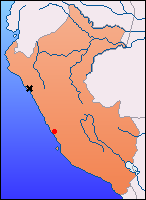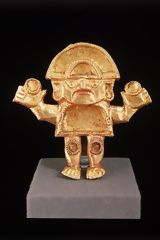 |
Associated pages: |
 The region of Lambayeque is a place of great historical and cultural importance, being the cradle of notable pre-Hispanic cultures such as the Mochica and Chimú. According to legend, the mythical figure Naylamp arrived on the shores of Lambayeque accompanied by his court and landed near the Faquisllanga River, where he ordered the construction of the temple Chot. In this temple, he placed the idol Yampallec, from which the name Lambayeque is derived. This fascinating legend remains alive in the region, and many believe that Naylamp is buried nearby, adding a mystical dimension to the local culture.
The region of Lambayeque is a place of great historical and cultural importance, being the cradle of notable pre-Hispanic cultures such as the Mochica and Chimú. According to legend, the mythical figure Naylamp arrived on the shores of Lambayeque accompanied by his court and landed near the Faquisllanga River, where he ordered the construction of the temple Chot. In this temple, he placed the idol Yampallec, from which the name Lambayeque is derived. This fascinating legend remains alive in the region, and many believe that Naylamp is buried nearby, adding a mystical dimension to the local culture.
The temple of Chot, identified today as the Huaca Chotuna, is located near Lambayeque Viejo. Representations of Naylamp are found on the famous tumis, the ceremonial knives used in rituals by the ancient civilizations of the region. The Lambayeque culture, which followed, became renowned for its exceptional goldsmithing, particularly in the creation of gold objects, some of which have been discovered in recent archaeological excavations.
One of the most impressive discoveries in Peruvian archaeology took place in this region: the tomb of the Lord of Sipán, an ancient Mochica ruler whose remains were found in an exceptional state of preservation. The discovery of the Lord of Sipán's tomb in 1987 revealed the complexity and wealth of the Mochica civilization. The objects found, including fine ceramics, gold and silver jewelry, and funerary masks, demonstrated the high artistic and cultural level of this civilization.
Today, visitors can view many of these objects at the Royal Tombs of Sipán Museum, located in Lambayeque. This museum is a must-see for anyone interested in ancient Peruvian history, as it houses one of the most important collections of pre-Columbian artifacts in the country.
Lambayeque is not only known for its ancient history but also for its vibrant tourism scene. The city of Chiclayo, the region's capital, is the starting point for exploring the wonders of Lambayeque. From Chiclayo, travelers can visit archaeological sites such as the Huaca Rajada, where the tomb of the Lord of Sipán was discovered. Visitors can also explore the Huaca del Pueblo and Huaca Las Ventanas, both containing significant remnants of the Mochica civilization.
Another essential visit is the Túcume Archaeological Complex, which features 26 adobe pyramids built by the Lambayeque and Sicán cultures. From the viewpoint on Cerro La Raya, visitors can enjoy an impressive panoramic view of the pyramids and the surrounding valley. The site also has a small museum that explains the history of Túcume and its cultural significance.
In addition to its rich cultural heritage, Lambayeque offers beautiful beaches along Peru's northern coast. Pimentel is one of the most popular beaches, known for its impressive waves and historic pier. It's an ideal spot for surfing enthusiasts as well as those looking to relax by the sea. During the summer months, the beach fills with tourists coming to enjoy the sun and sea. Another notable beach is Puerto Eten, a small fishing port with unique natural beauty.
Lambayeque is also famous for its delicious cuisine. The region's most well-known dish is arroz con pato (rice with duck), a flavorful combination of rice seasoned with cilantro and slow-cooked duck. Other typical dishes include northern ceviche, cabrito con frijoles (goat with beans), and seco de cabrito (braised goat). Additionally, the region is known for its chicha de jora, a fermented corn drink that has been consumed since pre-Hispanic times.
To fully enjoy Lambayeque, it is recommended to plan at least two or three days to explore all the archaeological sites and enjoy the beaches. It's advisable to visit the museums early in the morning to avoid crowds, especially during the high season (June to August). It's also important to bring light clothing, sunscreen, and water, as the region can be quite hot during the day.
With its fascinating history, dreamy beaches, and vibrant culture, Lambayeque offers a complete experience for those interested in ancient Peruvian history and the natural beauty of the northern coast.